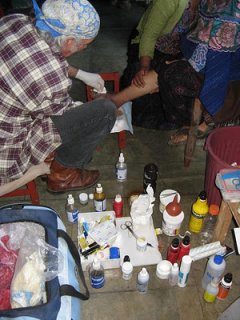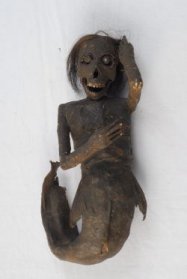Portrait of a Healer by Benjamin Mariotte
Mood:
 a-ok
Topic: Healing
a-ok
Topic: Healing

“If everybody acted in a simple and human way, we’d all be saints." --Don Sergio Castro, “El Andalón”
Three blocks from the’ zocalo’, the main square where at nightfall people gather to watch the Marimba municipal orchestra, in the charming city of San Cristobal de Las Casas, Sergio Castro receives the meek, the worthless, the outcasts of Mexican society in his free medical clinic.
Some of his patients are sent to him by local hospitals, especially in hopeless cases; when, for example, amputation seems to be the only option. Sergio is seen by many as the last hope. People come to him with gangrene, hoping that they will be able to keep their limbs, for he has achieved what some perceive as “miracles”. Sergio is not a doctor; Sergio’s somebody who really cares about people. And his clinic is actually not a clinic, but a museum of traditional indigenous costumes.
Sergio has been working within the indigenous Mayan communities of Chiapas, the poorest and most deprived State of Mexico, for the past 40 years. Initially, his contribution was agricultural work, and helping to build water infrastructure before he began offering medical care. Like all true healers, Sergio didn’t choose to become one. He was chosen, elected by the people who needed his help; and unlike many proclaimed healers, he’s never asked a dime for his services.
As compensation for his work, the indigenous offered him their traditional clothing, wooden artifacts, musical instruments, and a variety of other traditional items. In the 1970’s, having accumulated all this material Sergio had the idea of opening a museum to help him get some additional funding for the schools he was building in the communities, as well as to pay for the medicine he needed to treat his patients. Today, this museum is also a walk-in medical clinic, which is open every day except one. On Sundays, he visits the homes of those who are too incapacitated to come to his clinic. Don Sergio never stops, hence the title of a recently released documentary about his life, “El Andalon”, meaning, in Spanish, somebody who’s always on the go.
The first time I peeked through the half-opened door of Don Sergio’s unadvertised museum/clinic, a lovely lingering silence perspired in the place. On the walls, which escort one through the entrance door, hung some photos of indigenous folk in their colorful garb, on the back of the flowery and arboreal patio, rested some blue and green wooden crosses, inherent in the indigenous villages nearby.
As I stomped my way further in, I suddenly noticed at the back of the patio, a man standing still, arms akimbo and eyes absorbed, not unlike a painter would be with his subject. Next to him, three people huddled on a bench, sharing a similar contemplative disposition. Seated on a child-size chair, a bent man wearing a red bandana, his whole being entranced by its task, was the conductor of this soundless, hypnotic symphony. The scene struck me with a feeling of remote familiarity, as if it was already disposed in some part of my psyche, like the archetypical scene of a healing ceremony.
Something unique and grandiose was happening, and somehow, even before my eyes could actually apprehend the protagonists of this scene, something in the air was transmitting that information to my subtilized being. What was happening was that a human being, impaired by suffering and pain, was being taken care of by another human being. I chose to observe this scene from a distance, remaining at the entrance door.
The day after, I sat on the bench in the company of Sergio’s patients. Consumed by his gigantic task, Sergio doesn’t have any time to spare. A new patient seats himself while another one is leaving with a new bandage on. Don Sergio, as he is called by his patients, is sitting on a remarkably small chair which is a common sight in the local villages. In front of him, his patient is seated on a chair of equivalent size. An even smaller, Lilliputian chair is disposed in front of the patient’s seat where a leg or a foot can be rested. On the first day I visited the clinic, more than half of the patients came in with serious skin-related issues, such as wound infections, or gangrene, though people come to Sergio to be treated for all kinds of conditions, including cancer, epilepsy, or diabetes.
Sergio addresses his patients in Spanish, but also in Tzotzil and Tseltal, two of the main indigenous languages spoken in Chiapas. He is also fluent in English, French and Italian, which he picked up as he was giving international tourists guided tours of his museum and of the indigenous villages. Things in the clinic flow in a natural, steady, but not overwhelming pace, so that the small benches are usually sufficient for the day’s patients to wait their turn.
An old Tzotzil woman is carried in by her grandson, as a deep infection in her right foot prevents her from walking. Sergio will carefully remove her decrepit bandage soaked in a brownish-orange hue, clean the wound, and apply some anti-biotic cream and a fresh bandage. The old lady is in pain, and Sergio addresses her with gentle words that bring her attention to some distance away from the seething sensation of the pain. After the procedure, he tells the woman to come back in 3 days, so that he can see how things are evolving. Observing Sergio’s subtle and careful gestures is, in itself, very soothing. It slows things down and seems to cast out a different temporality. The old lady is carried away by her grandson, followed by five other members of the family who came to accompany her and kept the same sober stillness throughout the 10 minute procedure. Meanwhile, four other people are waiting on the bench for their turn to be treated.
Sergio’s knowledge is made up of subtle and empirical observations. Each one of his patients is seen as unique and is treated as such, in the personal way that regular physicians should take care of their patients. After his daily clinical work, he studies medical books. Constantly visited by thoughts, problems to solve, and reassessing some of his current cases, his nights aren’t exactly peaceful. “But healing is not just about finding a remedy to repair or counter an ailment”, says Sergio, “The medicine doesn’t work when a patient is feeling unnoticed or discarded. Sometimes a hug is what it takes to trigger healing”. The indigenous are wary of the hospital. They don’t feel welcome, and they aren’t. At Sergio’s, everybody is welcome with equal warmth and no one is charged. “Asking for money will add on to the stress that they already experience and will impair the healing process.” A heartfelt “gracias” is usually his sole compensation, though some will leave a bag of fruits or of fried tortillas.
Why is Sergio doing what he is doing? In the biographical documentary “ El Andalón”, Sergio mentions that his actions aren’t influenced by religion of politics, but that God just made him that way. Born in the northern Mexican State of Chihuahua, he learned about the fanciness of life in an orphanage. A freshly trained agronomist and veterinarian, Sergio chose to spend a year doing community work in the Southern part of Mexico, teaching the Maya indigenous communities how to improve their crops and vaccinating their animals. One day, a child was brought to him with severe burns, and Sergio, using the most rudimentary medical paraphernalia, managed to save him. From that day, the indigenous saw Sergio as their “ilol vinick”, Tzotzil for “healer”. The state of Chiapas was destined to become his home, and in many respects, this wild, mountainous, rebellious part of Mexico where the neo-Zapatista movement was born, befits him very well. Except that Sergio’s not a rebel, or one of a different kind; one who wishes that people would be more caring with each other. A down to earth pragmatist embedded in the present, Sergio deals with the real. Where there are no schools or drinking water facilities, he’s taking on the task of building some. So far, more than 35 schools have been erected in the indigenous communities thanks to his tireless efforts. Where there are unattended wounds and pain, he embraces the task of bringing solace and healing; every day, up to 30 patients benefit from his services.
Sergio is also married and the father of 7 children. How is his family dealing with all of this activity? “Well”, as Sergio says, “it’s a complicated situation; they have needs of their own”. But as Sergio also likes to say, reality in itself is very complicated, so he’s just has his share of complications.
Recently, another one of Sergio’s difficulty has become the funding part of his activities. The recession has taken its toll on his friends and supporters, the large majority of them being from the US and Europe, who used to provide him with funds and materials, and his fascinating museum, is not as popular as it used to be. At the time I was at Sergio’s, only a couple of people passed through the entrance door, not even knowing who Sergio was. On my second visit, after Sergio was done with his clinic work, he offered to give me and a woman, who presented herself as a “Maya investigator”, a tour of the museum, which started in a vast room outlined with dozens of different and unique traditional Maya costumes and items. Each indigenous community has its specific clothing with their own particular designs and patterns. Once you’re familiar with them, you can recognize which village (Zinacantan, Oxchuc, Huixtan, Tenejapa, etc.,) a person is from. Ten minutes into the tour, there was a knock at the door; a family with two children was asking for help, and Sergio interrupted the tour to give them assistance. As I chatted with the “investigator”, I learned that she was a psychotherapist, and part of a Maya investigation team at the University of Campeche. “We’re saving the Maya memory; we’re working on keeping our ancestors’ heritage alive”. When I asked her if she had visited the indigenous villages around San Cristobal, she replied that she was more interested in the ancient sacred Maya sites. The investigator waited five more minutes for Sergio’s return, before leaving. Another day, I met a French retiree living in San Cristobal for a couple of years, intending to write an autobiography. Incognizant of Sergio’s work, he wasn’t economic in expressing his appreciation of the cleanness of the street of San Cristobal and the cost of living there. When the conversation turned to the indigenous villages, he winced. “The begging children of San Juan Chamula and the tourists who go there annoy me.” Sounds like Maya fares better in books or movies than in real life.
Among the 4.5 million people living in Chiapas, 1 million are indigenous. Referred to as ‘Indios’, the indigenous are seen as an oddity, and an annoying one. Their language, their clothes, their traditions are too different and don’t fit with the modernization favored by the Mexican elite. As a consequence, the local and federal governments, along with society in general, discard the first of Mexico’s inhabitants.
Sergio’s dedication to assuaging the daily life of the indigenous brings him in direct lineage with the first indigenous activist and first bishop of Chiapas in the 16th century, Bartholomé de Las Casas. Because of his efforts to raise awareness about the fate of the indigenous, his name was honored, in 1848, when it was added to the name of the city of San Cristobal. Treated as a peer in the indigenous communities, fluent in three of the Mayan dialects spoken in Chiapas, Don Sergio is the godfather of 70 children in the Tzotzil community of Chamula, which consists of 75,000 people and located in the outskirts of San Cristobal de Las Casas.
When I departed Chiapas and saw Sergio for the last time, I felt that I was leaving a unique kind of human being, a “Grand Soul” whose life sheds some light on what’s worth it and what isn’t, what’s meaningful, nourishing, fulfilling, and what makes us feel meaningless, what separates us, making us insensitive and unavailable to just “be” with our fellows.
Today, facing financial hardship, struggling to pay for the medication of his patients and the rent for this museum, Sergio’s bracing himself, but his labor continues, every day, away from the lights of the world.
Sergio is “el andalón”; the one who cannot be stopped. The end of the world, according to interpretations of the Maya calendar, may come to pass soon, Sergio will still be going somewhere with his cowboy boots, holding a weary bag with his medical paraphernalia, for the world he is living in might be a complicated and challenging one, but it isn’t one that can come to an end.
Article Source - dailygood.org
Posted by Neil Bartlett DHyp M.A.E.P.H
at 01:01 CET
Updated: Thursday, 16 February 2012 01:16 CET






